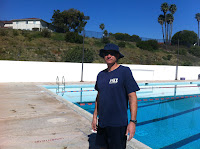By: Jessica Hughes on July 22, 2013
 In Long Beach, Calif., rescue divers searching for submerged victims once swam patterns near blind through murky waters — but they now have the gift of “sight” thanks to a new handheld sonar device.
In Long Beach, Calif., rescue divers searching for submerged victims once swam patterns near blind through murky waters — but they now have the gift of “sight” thanks to a new handheld sonar device.
The Long Beach Fire Department recently acquired the technology, called the Shark Marine Navigator, so that the city’s Public Safety Dive Team can conduct even quicker rescues — and act with sight during that 20-minute sensitive period where victims still have a chance of survival.
“For us it’s just night and day; clearly, it’s the ability to see where you couldn’t see before,” said Gonzalo Medina, operations captain for the Long Beach Fire Department’s Marine Safety Division.
During rescue missions, divers steer the heavy-duty device and its laptop-size screen through the water using its metal handles. The device illuminates up to 250 meters underwater in zero visibility, and also has the capacity to take video and photographs. All the information is stored, and can be managed and shared using the device’s software, according to Shark Marine’s Web site.
The device’s display is similar to an ultrasound — the 2D version, that is, with some depth. Medina said the diver can see green tones, where bright green indicates something is there. And it is easy to see objects that are out of the ordinary, he said, such as a body.
The city’s fire department purchased its Shark Marine Navigator for $200,000, using federal Port Security Grant Program funds, Medina said. The city’s police department, which also has divers on the dive team, has two of the devices for its underwater investigative efforts.
Medina said the city’s dive team, which also includes the port’s salvage efforts, has focused more recently on conducting even quicker rescues — and deploying new technology toward that aim. For instance, divers are now available 24/7 to respond either by boat or truck. In fact, the new device is stationed on the team’s Marine Safety Rescue Boat, ready to deploy at a moment’s notice.
“This technology allows us to make those rescues much quicker and get patients care, which greatly increases their chance of survival,” said Medina, who is also the team’s dive officer.
Although the device has not been used in a search and rescue yet, all 15 fire department divers are learning to use it during lifelike scenarios, Medina said, adding that he is in awe of how much easier the diver’s job looks using the technology.
Still, there’s a learning curve.
For instance, divers need to float several feet above the bottom so that the device can identify more of its surroundings — much like how a flashlight casts a wider glow when it is held away from a surface as opposed to close to it, he said.
Once the target is found, the technology can be used like Google Maps, with the diver dropping a target on the device’s screen and then kicking toward that target.
Though the device was originally developed for military divers to navigate the water unnoticed, Long Beach — home to the second busiest seaport in the country as well as many bridges and waterways –will use the device in cases where vehicles are submerged or swimmers are lost, with at least a few of these cases reported per year, Medina said. Many times, he said, they happen after hours or during Long Beach’s off season when no life guard is on duty.
While submersions don’t happen often, they can be costly in time, money and manpower. The new technology cuts down on personnel costs because it makes for “a more efficient and lean operation,” Medina said. Also, a modular design allows the device to evolve with new technologies, according to Shark Marine.
The use of sonar is not new, but the dive team’s old sonar device was deployed during the recovery period, and not during the rescue mission as is envisioned for the new device. Previously, rescuers watching a laptop connected to a sonar tripod circling the water remotely directed the divers.
This roundabout communication worked, but it meant for a long process, Medina said, and so the information wasn’t used until one hour after the mission began — after the hope of rescuing the victim had passed.
The primary difference, then, is that the new device is in the water with the divers. “It’s the difference between an iPad and a huge desktop,” Medina said. “You can do everything with the desktop but you can’t move with it.” And that difference, he said, is a game changer.
Marine Safety Chief Randy Foster echoed how important the new technology is for the city’s divers, saying, “This new technology is the most significant advancement in the arena of public safety diving in the past 15 years.”
 The man was operating a utility tractor rig on a dock at the Evergreen terminal when it fell into the main channel off Terminal Island on Monday afternoon.
The man was operating a utility tractor rig on a dock at the Evergreen terminal when it fell into the main channel off Terminal Island on Monday afternoon.

















































